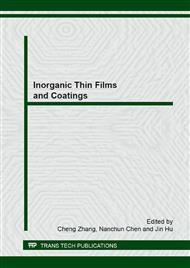[1]
D. Zhong, E. Sutter, J.J. Moore, et al., Composition and oxidation resistance of Ti–B–C and Ti–B–C–N coatings deposited by magnetron sputtering, Surf Coat Technol. 163-164 (2003) 50.
DOI: 10.1016/s0257-8972(02)00587-x
Google Scholar
[2]
G. Tang, X. Ma, Magnetron sputtering deposition Ti-B-C-N films by Ti/B4C compound target, Surf Coat Technol. 203 (2009) 1288-1291.
DOI: 10.1016/j.surfcoat.2008.10.038
Google Scholar
[3]
Y.G. Shen, Y.W. Mai, Residual stress, microstructure, and structure of tungsten thin films deposited by magnetron, Journal of Applied Physics 87 (2000) 177.
DOI: 10.1063/1.371841
Google Scholar
[4]
D.Zhong, E. Mateeva, I.Dahan, et al., Wettability of NiAl, Ni-Al-N, Ti-B-C, and Ti-B-C-N films by glass at high temperatures, Surf Coat Technol. 133-134 (2000) 8
DOI: 10.1016/s0257-8972(00)00877-x
Google Scholar
[5]
H.Gleiter, Nanostructured materials: basic concepts and microstructure, Acta Mater 48 (2000) 1-29
Google Scholar
[6]
P. Eh. Hovsepian, D.B. Lewis and W. D. Münz, Recent progress in large scale manufacturing of multilayer/superlattice hard coatings, Surf Coat Technol. 133 (2000) 166-175.
DOI: 10.1016/s0257-8972(00)00959-2
Google Scholar
[7]
A. Vyas, Y.H. Lu, Y.G. Shen, Mechanical and tribological properties of multicomponent Ti–B–C–N thin films with varied C contents, Surf Coat Technol. 204 (2010) 1528-1534.
DOI: 10.1016/j.surfcoat.2009.09.078
Google Scholar
[8]
D. Zhong, E. Sutter, J.J. Moore, et al., Mechanical properties of Ti–B–C–N coatings deposited by magnetron sputtering, Thin Solid Films 398-399 (2001) 320-325.
DOI: 10.1016/s0040-6090(01)01344-x
Google Scholar
[9]
M.Y. Liu, J.Y. Yan, S. Zhang, et al., The Effect of deposition temperature and work pressure on Ti-B-C nanocomposite coating prepared by multitarget magnetron cosputtering, Plasma Science 39 (2011) 3115-3119.
DOI: 10.1109/tps.2011.2162081
Google Scholar
[10]
G.C.A.M. Janssen, M.M. Abdalla, F. van Keulen, B.R. Pujada and B. van Venrooy, Celebrating the 100th anniversary of the Stoney equation for film stress: Developments from polycrystalline steel strips to single crystal silicon wafers, Thin Solid Films 517 (2009) 1858–1867.
DOI: 10.1016/j.tsf.2008.07.014
Google Scholar
[11]
W.C. Oliver and G.M. Pharr, An improved technique for determining hardness and elastic modulus using load and displacement sensing indentation experiments, J. Mater. Res. 7 (1992) 1564-1583.
DOI: 10.1557/jmr.1992.1564
Google Scholar
[12]
J. Musil and J. V.ceka, Magnetron sputtering of hard nanocomposite coatings and their Properties, Surf Coat Technol. 142 (2001) 557-566.
DOI: 10.1016/s0257-8972(01)01139-2
Google Scholar
[13]
J. Musil, P. Zeman, H. Hrubý and P. H. Mayrhofer, Hard and superhard nanocomposite coatings, Surf Coat Technol. 125 (2000) 322-330.
Google Scholar
[14]
S. Veprek, New development in superhard coatings: the superhard nanocrystalline amorphous composites, Thin Solid Films 317 (1998) 449-454.
DOI: 10.1016/s0040-6090(97)00665-2
Google Scholar
[15]
S. Veprek, R.F. Zhang, M.G.J. Veprek-Heijmana, et al., Superhard nanocomposites: Origin of hardness enhancement properties and applications, Surf Coat Technol. 204 (2010) 1898–1906.
DOI: 10.1016/j.surfcoat.2009.09.033
Google Scholar
[16]
X.Y. Chen, Z.H. Wang, et al., Microstructure, mechanical and tribological properties of Ti–B–C–N films prepared by reactive magnetron sputtering, Diam. Relat. Mater. 19 (2010) 1336-1340.
DOI: 10.1016/j.diamond.2010.07.002
Google Scholar


